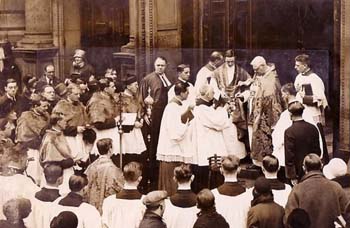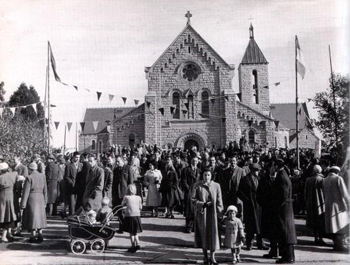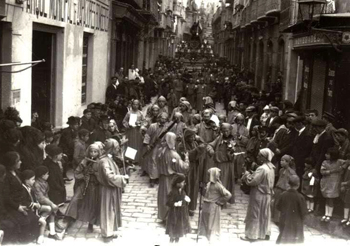Traditionalist Issues
 |
 |
 |
 |
 |
 |
 |
Dialogue Mass - XVIII
Maxima Redemptionis, a ‘Potemkin Façade’
In the previous article we saw how Pope Pius XII’s Liturgical Commission conducted the Easter Vigil survey among the members of the Church’s Hierarchy in 1951. By counting the hits and ignoring the misses, so to speak, Bugnini and his henchmen arrived at conclusions that were not fully supported by the data.
The result was a partial, over-simplistic and highly fanciful picture of the general opinion among the world’s Bishops on the Easter Vigil ceremonies. Yet it was this self-serving interpretation, which acted as the starting gun for the Holy Week reforms, that would be imposed on the Church in 1955.
A ‘Potemkin façade’
 But why was there no external or independent evaluation to ensure an objective scrutiny of the results? Why was Mgr. Léon Gromier, for instance, not consulted?
But why was there no external or independent evaluation to ensure an objective scrutiny of the results? Why was Mgr. Léon Gromier, for instance, not consulted?
Pius XII could hardly have expected the Commission to act as a dispassionate evaluator of the evidence when he knew that the people running the survey had an obvious interest in a favorable outcome for the Liturgical Movement. This institutionalized conflict of interest should be called by its proper name: fraud.
The evidence available so far indicates that this was a survey forged in a crucible of secrecy and deception. Like all “Potemkin façades,” (1) it was designed solely to deceive others with an elaborate and impressive result and thus impress the credulous.
Spinning a false narrative
Maxima Redemptionis told us that attendance at all the Holy Week rites had been decreasing since the Middle Ages to the point where, by the 20th century, “common and almost universal experience teaches that these liturgical services of the sacred Triduum are often performed by the clergy with the body of the church nearly deserted.”
It placed the blame for this alleged state of affairs on the Church’s scheduling of these services to the morning hours “when, on weekdays, schools, businesses and public affairs of all kinds were and are conducted everywhere.”
It is difficult to know where to start to evaluate the accuracy of these broad and sweeping generalizations encompassing not just centuries but the dizzying complexity of the myriad parishes all over the world.
The salient feature of the Liturgical Commission’s survey was its intentional lack of perspective. No allusion was made to the many historical variables that may have affected the levels of attendance at the Holy Week services since the Middle Ages, such as the Pseudo-Reformation, the French and Russian Revolutions, the two World Wars and the persecution of Catholics in various countries around the world.
While there were bound to be churches where the Easter Vigil was not well attended, this may have been due to any number of causes – for instance difficulty of access in remote areas, shortage of clergy, absence of apostolic zeal or even the effects of the Liturgical Movement itself.
We are entitled, therefore, to ask: What percentage of the alleged diminution in attendance was due to the morning celebration of the Easter Vigil? The fact that other contributory factors were intentionally ignored means that the argument rests on shaky grounds.
An invented scenario too implausible to be true
If the opinion expressed in Maxima Redemptionis were true, we would have been constantly hearing from our pastors or reading in the Catholic papers about a momentous dearth of support for the Holy Week services. But, of course, there was no such situation. Good Friday has long been a widely-held national holiday in most countries, and Maundy Thursday in many, (2) and most Catholics were free – or could arrange to be free – to attend Church services then as well as on Holy Saturday morning. (3)
 But Bugnini did not need arguments that could be proven, only those that could not easily be disproven by his opponents. His tactic was to present incomplete, out of context and misleading information to unsuspecting faithful who were in no position to judge its accuracy on a world-wide scale; they would have no means of identifying the mismatch between the assumption and the facts.
But Bugnini did not need arguments that could be proven, only those that could not easily be disproven by his opponents. His tactic was to present incomplete, out of context and misleading information to unsuspecting faithful who were in no position to judge its accuracy on a world-wide scale; they would have no means of identifying the mismatch between the assumption and the facts.
Even if the claim happened to be true – although its veracity is far from established – it by no means followed that changing the Holy Week liturgy would increase attendance.
Up until 1955, there is ample reason to believe that the Holy Week services were well attended. Although few people are alive today to provide memories of the pre-1955 ceremonies, there is an alternative source of information: contemporary newspaper coverage.
Maxima Redemptionis disregarded the reality on the ground
All we have to do is search the archives of various Catholic newspapers dating from the late 19th to the mid-20th century or the Pathe newsreels to provide a reality check. These attest to the fact that Catholics flocked to the Holy Week services, including the Easter Vigil, in great numbers.
Here are a few representative examples from the London area which could be multiplied around the world:

 • 1898: “The services at Farm Street (4) and at the Oratory (5) were also followed by dense throngs. Never does there seem to have been greater fervour in the churches during Holy Week in London.” (6) [see
here]
• 1898: “The services at Farm Street (4) and at the Oratory (5) were also followed by dense throngs. Never does there seem to have been greater fervour in the churches during Holy Week in London.” (6) [see
here]
• 1917: “The churches were crowded at all the Holy Week services until the dawn of the new Easter Day.” [see here - emphasis added] (7)
• 1920: “Mass of the Presanctified was celebrated on Good Friday in the presence of a congregation which filled the Cathedral.” (8) [see here]
• 1920: “A commentary upon the sterling Catholicity of the working classes of South London is the fact that they attended in large numbers the services of Holy Week and Easter.” (9)
• 1920: “At the Church of the English Martyrs [Streatham] on Good Friday, Dr. Terry's setting of the music was finely rendered by the voluntary choir, the conductor being Mr. Collis, the organist, formerly of Westminster Cathedral. There was a crowded congregation throughout the day.” (10)
None of these accounts comes anywhere near the description of almost deserted churches found in Maxima Redemptionis. Indeed, by one of those delicious ironies of which history is replete, Romano Guardini himself inadvertently revealed the non-sense in this claim.
Having visited the Basilica of Monreale, Sicily, during Holy Week of 1929, he recorded how impressed he was that on Holy Thursday “the ample space was crowded.” and attendance at the Easter Vigil service filled “almost every part of that great church.” (11)
Irony heaped upon irony, ruin upon ruin
It was only in 1956 when Maxima Redemptionis came into force that disaffection with the new Holy Week rites set in among many of the faithful, especially those who were most attached to the traditional ceremonies.
The result was that as soon as the novelty wore off, attendance began to fall (12) and the Holy Week services are still playing to rapidly diminishing audiences. Even worse, the administration of Baptism which was meant to be a high feature of the progressivist rites has plummeted to a level unprecedented in the history of the Church.
What more ironic indictment could there be of a key objective of the Holy Week reform which was to increase attendance? Fr. Ferdinando Antonelli, later Cardinal, who had been given chief responsibility for its implementation, had confidently explained in 1955 that the motives for the changes were “of a pastoral nature; that is, to bring the masses of the faithful back to the commemoration of the holiest mysteries of Christ’s Passion and Death.” (13)
What neither he nor the other Bugnini-bots on the Commission realized was that the Holy Week reform, not being built on the solid rock of Tradition, had all the stability of a house of cards. It is hardly surprising, therefore, that it was subject to imminent collapse.
Continued

The result was a partial, over-simplistic and highly fanciful picture of the general opinion among the world’s Bishops on the Easter Vigil ceremonies. Yet it was this self-serving interpretation, which acted as the starting gun for the Holy Week reforms, that would be imposed on the Church in 1955.
A ‘Potemkin façade’

A kind of Potemkin-façade intended to deceive passersby
Pius XII could hardly have expected the Commission to act as a dispassionate evaluator of the evidence when he knew that the people running the survey had an obvious interest in a favorable outcome for the Liturgical Movement. This institutionalized conflict of interest should be called by its proper name: fraud.
The evidence available so far indicates that this was a survey forged in a crucible of secrecy and deception. Like all “Potemkin façades,” (1) it was designed solely to deceive others with an elaborate and impressive result and thus impress the credulous.
Spinning a false narrative
Maxima Redemptionis told us that attendance at all the Holy Week rites had been decreasing since the Middle Ages to the point where, by the 20th century, “common and almost universal experience teaches that these liturgical services of the sacred Triduum are often performed by the clergy with the body of the church nearly deserted.”
It placed the blame for this alleged state of affairs on the Church’s scheduling of these services to the morning hours “when, on weekdays, schools, businesses and public affairs of all kinds were and are conducted everywhere.”
It is difficult to know where to start to evaluate the accuracy of these broad and sweeping generalizations encompassing not just centuries but the dizzying complexity of the myriad parishes all over the world.
The salient feature of the Liturgical Commission’s survey was its intentional lack of perspective. No allusion was made to the many historical variables that may have affected the levels of attendance at the Holy Week services since the Middle Ages, such as the Pseudo-Reformation, the French and Russian Revolutions, the two World Wars and the persecution of Catholics in various countries around the world.
While there were bound to be churches where the Easter Vigil was not well attended, this may have been due to any number of causes – for instance difficulty of access in remote areas, shortage of clergy, absence of apostolic zeal or even the effects of the Liturgical Movement itself.
We are entitled, therefore, to ask: What percentage of the alleged diminution in attendance was due to the morning celebration of the Easter Vigil? The fact that other contributory factors were intentionally ignored means that the argument rests on shaky grounds.
An invented scenario too implausible to be true
If the opinion expressed in Maxima Redemptionis were true, we would have been constantly hearing from our pastors or reading in the Catholic papers about a momentous dearth of support for the Holy Week services. But, of course, there was no such situation. Good Friday has long been a widely-held national holiday in most countries, and Maundy Thursday in many, (2) and most Catholics were free – or could arrange to be free – to attend Church services then as well as on Holy Saturday morning. (3)

An Easter Vigil at Westminster Cathedral in the 1930s attended by a crowd of faithful
Even if the claim happened to be true – although its veracity is far from established – it by no means followed that changing the Holy Week liturgy would increase attendance.
Up until 1955, there is ample reason to believe that the Holy Week services were well attended. Although few people are alive today to provide memories of the pre-1955 ceremonies, there is an alternative source of information: contemporary newspaper coverage.
Maxima Redemptionis disregarded the reality on the ground
All we have to do is search the archives of various Catholic newspapers dating from the late 19th to the mid-20th century or the Pathe newsreels to provide a reality check. These attest to the fact that Catholics flocked to the Holy Week services, including the Easter Vigil, in great numbers.
Here are a few representative examples from the London area which could be multiplied around the world:

Above, a 1950s Irish parish in the U.S. - filled with people for Holy Week services; below, whole villages in Spain taking part in Holy Week ceremonies in 1911

• 1917: “The churches were crowded at all the Holy Week services until the dawn of the new Easter Day.” [see here - emphasis added] (7)
• 1920: “Mass of the Presanctified was celebrated on Good Friday in the presence of a congregation which filled the Cathedral.” (8) [see here]
• 1920: “A commentary upon the sterling Catholicity of the working classes of South London is the fact that they attended in large numbers the services of Holy Week and Easter.” (9)
• 1920: “At the Church of the English Martyrs [Streatham] on Good Friday, Dr. Terry's setting of the music was finely rendered by the voluntary choir, the conductor being Mr. Collis, the organist, formerly of Westminster Cathedral. There was a crowded congregation throughout the day.” (10)
None of these accounts comes anywhere near the description of almost deserted churches found in Maxima Redemptionis. Indeed, by one of those delicious ironies of which history is replete, Romano Guardini himself inadvertently revealed the non-sense in this claim.
Having visited the Basilica of Monreale, Sicily, during Holy Week of 1929, he recorded how impressed he was that on Holy Thursday “the ample space was crowded.” and attendance at the Easter Vigil service filled “almost every part of that great church.” (11)
Irony heaped upon irony, ruin upon ruin
It was only in 1956 when Maxima Redemptionis came into force that disaffection with the new Holy Week rites set in among many of the faithful, especially those who were most attached to the traditional ceremonies.
The result was that as soon as the novelty wore off, attendance began to fall (12) and the Holy Week services are still playing to rapidly diminishing audiences. Even worse, the administration of Baptism which was meant to be a high feature of the progressivist rites has plummeted to a level unprecedented in the history of the Church.
What more ironic indictment could there be of a key objective of the Holy Week reform which was to increase attendance? Fr. Ferdinando Antonelli, later Cardinal, who had been given chief responsibility for its implementation, had confidently explained in 1955 that the motives for the changes were “of a pastoral nature; that is, to bring the masses of the faithful back to the commemoration of the holiest mysteries of Christ’s Passion and Death.” (13)
What neither he nor the other Bugnini-bots on the Commission realized was that the Holy Week reform, not being built on the solid rock of Tradition, had all the stability of a house of cards. It is hardly surprising, therefore, that it was subject to imminent collapse.
Continued
- The pejorative expression “Potemkin façades” comes from the 18th-century Russian Minister, Gregory Potemkin, a favorite of Empress Catherine II. When Catherine decided to visit the Crimea in 1787 to inspect that part of her Empire, Potemkin allegedly erected fake settlements along the banks of the Dnieper River so that she would think the poverty-stricken area was a prosperous and thriving place. He is also said to have provided crowds of waving and cheering peasants to impress the Empress as she cruised down the river.
It is tempting to draw a real life parallel with Bugnini and his attempts to beguile the reigning Pontiff, Pius XII into believing that all the Bishops were cheering the start of the liturgical reform.
The expression is now used, especially in politics and economics, to describe any construction (literal or figurative) built to hide an adverse fact or situation. - Countries where Maundy Thursday is a public holiday include Argentina, Colombia, Costa Rica, Denmark, Guatemala, Iceland, Mexico, Nicaragua, Norway, Paraguay, Peru, the Philippines, Spain and Uruguay.
- Catholic families often took time off work during the long Easter weekend. It is a longstanding custom that government offices and many businesses do not operate on Saturday, leaving many Catholics free to attend the morning Easter Vigil. In countries where it was customary for children to attend school on Saturday mornings – even in the unlikely event that this applied to Holy Saturday – it was within the remit of teachers in Catholic schools to accompany their charges to Church services.
- The Church of the Immaculate Conception at Farm Street, Mayfair, in London has been run by the Jesuits since its establishment in the 1840s. In pre-Vatican II times, it was famous for its phenomenal success in making many thousands of converts to the Church.
- Established in the mid 19th century, the London Oratory was the largest church in London before the building of Westminster Cathedral.
- The Tablet, 16 April 1898
- Ibid., 14 April 1917
- ‘Easter in the Churches,’ The Tablet, 10th April 1920
- Ibid.
- Ibid.
- Translated from ‘Reise nach Sizilien’ (Voyage in Sicily) in Romano Guardini, Spiegel und Gleichnis. Bilder und Gedanken (Mirror and Parable: Images and Thoughts), Mainz-Paderbon: Grünewald-Schöningh, 1990, pp. 158-161.
- “Now that the novelty is wearing off, parishes in many areas report dwindling congregations.” Fr John Coyne, ‘The Traditional Position’, in Charles Cunliffe (ed.), English in the Liturgy: A Symposium, Templegate, 1956, p. 97.
- Fr. Ferdinando Antonelli, L'Osservatore Romano, November 1955

Posted April 6, 2015
______________________
______________________
 Volume I |
 Volume II |
 Volume III |
 Volume IV |
 Volume V |
 Volume VI |
 Volume VII |
 Volume VIII |
 Volume IX |
 Volume X |
 Volume XI |
 Special Edition |


